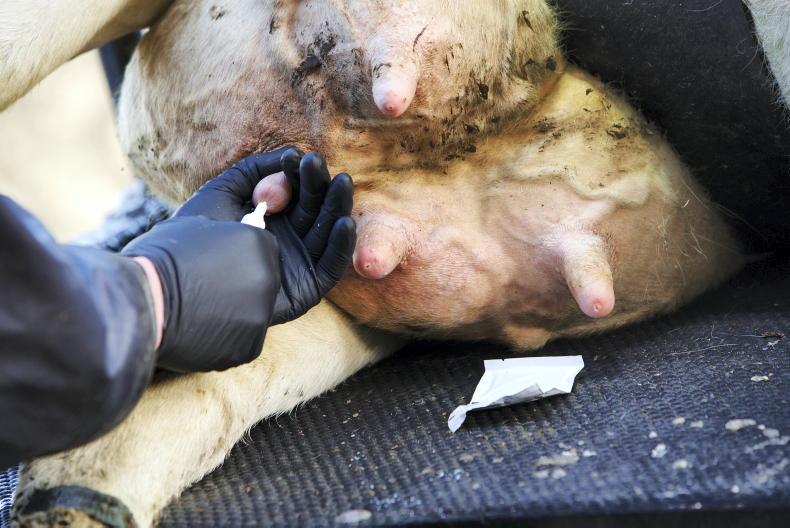A lot of farms will be doing their last milk recording in the coming weeks before cows are dried off. Milk recording is one of the most important pieces of measured performance on a dairy farm, where the volume and the quality of milk is measured.
Milk recording cows is a bit like recording how many goals a striker is scoring every year in a soccer team. If one player scores 15 goals in the season and the other scores only 10, the manager will start the first player on the team (and might sell the other).
Recording performance in cows helps the farmer make better decisions about breeding, milk quality and which cows to sell from the herd.
Most farmers will milk record their cows at least four times a year.

Samples must be taken from each cow. Photo: Donal O' Leary
Recording meters are attached to the individual milking units and a sample is taken from each cow. The meters record the volume of milk the cow gave that evening and the sample is sent away to a lab. The sample is tested and will tell us the cow’s somatic cell count (SCC) as well as the percentage of fat, protein and lactose in the milk.
Recording is done once during evening milking, where samples are taken, and again during the morning milking, to get an accurate reading of how much milk a cow produces in a day. A hand-held device is used to input the cow numbers, which identifies which sampling bottle is which.
Report
Once the samples are tested in the lab, a report is sent back to the farmer for each cow. They can then go through the report and see which are the best and worst cows – a lot like the ‘top scorers’ list in the Premier League.

First recording should be done 60 days after the first cow calves. Photo: Donal O' Leary
To get the most accurate reading for the herd, the first recording of the year should be done 60 days after the first cow calves every year. The last recording should be done just before drying off to get a good reading of SCC in the herd.
Here are some reasons why milk recording is important:
It identifies the best and worst cows: milk recording lets farmers track the milk yield and quality results of each of their cows. This information helps farmers make management decisions, such as which cows are underperforming and may be suitable to cull, or it will tell them which cows are producing in the system and are more suitable to breed new calves to join.
Repeat offenders
If a farmer regularly milk records their cows, this will allow them to keep track of the SCC of each cow. They can then use this to identify and manage the repeat offenders. This could decrease the herd’s overall SCC and improve milk price and quality.
Farmers are better paid for their milk if the quality is higher than the average in the country. Protein is the highest valued content in the milk, then fat. To make it easier for factories to take fat and protein from the milk, the higher fat and protein in the milk the better. The farmer can go through the milk recording report and tell which cows have the highest fat and protein in the herd. The farmer will then know which cows to breed from to keep improving his herd every year.
A lot of farms will be doing their last milk recording in the coming weeks before cows are dried off. Milk recording is one of the most important pieces of measured performance on a dairy farm, where the volume and the quality of milk is measured.
Milk recording cows is a bit like recording how many goals a striker is scoring every year in a soccer team. If one player scores 15 goals in the season and the other scores only 10, the manager will start the first player on the team (and might sell the other).
Recording performance in cows helps the farmer make better decisions about breeding, milk quality and which cows to sell from the herd.
Most farmers will milk record their cows at least four times a year.

Samples must be taken from each cow. Photo: Donal O' Leary
Recording meters are attached to the individual milking units and a sample is taken from each cow. The meters record the volume of milk the cow gave that evening and the sample is sent away to a lab. The sample is tested and will tell us the cow’s somatic cell count (SCC) as well as the percentage of fat, protein and lactose in the milk.
Recording is done once during evening milking, where samples are taken, and again during the morning milking, to get an accurate reading of how much milk a cow produces in a day. A hand-held device is used to input the cow numbers, which identifies which sampling bottle is which.
Report
Once the samples are tested in the lab, a report is sent back to the farmer for each cow. They can then go through the report and see which are the best and worst cows – a lot like the ‘top scorers’ list in the Premier League.

First recording should be done 60 days after the first cow calves. Photo: Donal O' Leary
To get the most accurate reading for the herd, the first recording of the year should be done 60 days after the first cow calves every year. The last recording should be done just before drying off to get a good reading of SCC in the herd.
Here are some reasons why milk recording is important:
It identifies the best and worst cows: milk recording lets farmers track the milk yield and quality results of each of their cows. This information helps farmers make management decisions, such as which cows are underperforming and may be suitable to cull, or it will tell them which cows are producing in the system and are more suitable to breed new calves to join.
Repeat offenders
If a farmer regularly milk records their cows, this will allow them to keep track of the SCC of each cow. They can then use this to identify and manage the repeat offenders. This could decrease the herd’s overall SCC and improve milk price and quality.
Farmers are better paid for their milk if the quality is higher than the average in the country. Protein is the highest valued content in the milk, then fat. To make it easier for factories to take fat and protein from the milk, the higher fat and protein in the milk the better. The farmer can go through the milk recording report and tell which cows have the highest fat and protein in the herd. The farmer will then know which cows to breed from to keep improving his herd every year.











SHARING OPTIONS